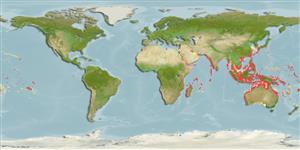Common names from other countries
Environment: milieu / climate zone / depth range / distribution range
Écologie
; saumâtre; profondeur 0 - 50 m (Ref. 343). Tropical; 26°C - 30°C (Ref. 111153), preferred 25°C (Ref. 107945); 34°N - 37°S, 22°E - 134°W
Indo-West Pacific. Introduced in Hawaii and USA.
Length at first maturity / Taille / Poids / Âge
Maturity: Lm 6.9, range 8 - ? cm Max length : 28.0 cm CW mâle / non sexé; (Ref. 343); poids max. publié: 3.0 kg (Ref. 343)
Description synthétique
Morphologie
Carapace smooth, with strong transverse ridges; H-shaped gastric groove deep; relatively broad frontal lobes, all more or less in line with each other; broad anterolateral teeth, projecting obliquely outwards. Well-developed present on outer surface of chelipedal carpus and anterior and posterior dorsal parts of the palm. Color: carapace green to almost black; legs may be marbled.
Maximum carapace width: between 25 and 28 cm. Maximum weight between 2 and 3 kg. Also collected by baited wire mesh pots. Sold in Taiwan, Hong Kong and Singapore, where the large crabs (so called "meat crabs") and females with ripe ovaries ("roe crabs") command a price from US$5 to US$10 per kg. Largest exporters of this species are Indonesia, Sri Lanka, India, and Bangladesh. There have been attempts to culture the crabs in captivity, but none of the closed-cycle enterprise have gone commercial. Tide is relied upon by farms to bring megalopae or late zoeae into grow-out ponds. Prefers oceanic waters, usually found just offshore on soft muddy bottoms (Also Ref. 9773). Can be caught up to 50 m offshore as it migrates offshore to spawn (Ref. 343). Subtidal (Ref. 106854). Digs deep burrows in mangroves and soft substrates in shallow or intertidal waters (Refs. 343, 9773). Found in brackish to sea water (Ref. 77016). Forages at night. Major predator (Also Ref. 128960) of small invertebrates colonizing mangrove swamps (Ref. 8752). Feeds on shrimps, crabs, fishes, and bivalves (Refs. 99886, 102679). Benthic scavenger but prefers oysters (Ref. 9773).
Life cycle and mating behavior
Maturité | Reproduction | Frai | Œufs | Fécondité | Larves
Gonochoric; sexually dimorphic based on secondary characteristics. The male traps the female under its chest, holding the latter with its chelipers, forming a pair. When the female is about to molt, the male releases but remains nearby. After moulting, the female is again trapped by the male and the latter opens its genitals towards the female's abdomen. Coupling may last from seven to twelve hours (Ref. 99880) and occurs at the bottom of the burrows; spawning occurs five weeks after mating. Migration: young crabs (2 cm CL) attend to estuarine waters and leave to enter the mangroves at lengths 7-9 cm for males and 8 cm for females; after which they return to the sea (Ref. 99886).
Ng, P.K.L. 1998. (Ref. 343)
Statut dans la liste rouge de l'IUCN (Ref. 130435)
statut CITES (Ref. 108899)
Not Evaluated
Not Evaluated
Utilisations par l'homme
Pêcheries: commercial
FAO - Aquaculture: production, species profile; pêcheries: landings, species profile | FishSource | Sea Around Us
Outils
Sources Internet
Estimates based on models
Preferred temperature
(Ref.
115969): 24.5 - 29.1, mean 28.1 (based on 1290 cells).
Résilience
Haut, temps minimum de doublement de population inférieur à 15 mois (K=0.43).
Prior r = 1.17, 95% CL = 0.77 - 1.75, Based on 3 data-limited stock assessments.
Vulnérabilité
Low vulnerability (18 of 100).
